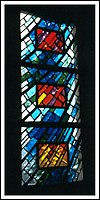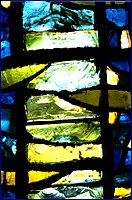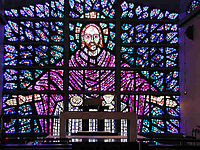
Buckfast Abbey forms part of an active Benedictine monastery at Buckfast, near Buckfastleigh, Devon, England. Buckfast first became home to an abbey in 1018. The first Benedictine abbey was followed by a Savignac, later Cistercian, abbey constructed on the site of the current abbey in 1134. The monastery was surrendered for dissolution in 1539, with the monastic buildings stripped and left as ruins, before being demolished. The former abbey site was used as a quarry, and later became home to a Gothic mansion house.

Stained glass is coloured glass as a material or works created from it. Throughout its thousand-year history, the term has been applied almost exclusively to the windows of churches and other significant religious buildings. Although traditionally made in flat panels and used as windows, the creations of modern stained glass artists also include three-dimensional structures and sculpture. Modern vernacular usage has often extended the term "stained glass" to include domestic lead light and objets d'art created from foil glasswork exemplified in the famous lamps of Louis Comfort Tiffany.

A countertop, also counter top, counter, benchtop, worktop or kitchen bench, bunker is a raised, firm, flat, and horizontal surface. They are built for work in kitchens or other food preparation areas, bathrooms or lavatories, and workrooms in general. The surface is frequently installed upon and supported by cabinets, positioned at an ergonomic height for the user and the particular task for which it is designed. A countertop may be constructed of various materials with different attributes of functionality, durability and aesthetics, and may have built-in appliances, or accessory items relative to the intended application.

Conrad Schmitt Studios is an architectural arts studio located in New Berlin, Wisconsin. It provides ecclesiastical art, stained glass artistry, art glass, decorative painting, mosaics, murals and sculptural arts. The studio specializes in restoration services for buildings of architectural, historical and religious significance. Founded in 1889 by German-American artist Conrad Schmitt, the company is one of the oldest and largest glass studios in the United States.
The firm of James Powell and Sons, also known as Whitefriars Glass, were London-based English glassmakers, leadlighters and stained-glass window manufacturers. As Whitefriars Glass, the company existed from the 17th century, but became well known as a result of the 19th-century Gothic Revival and the demand for stained glass windows.

Gabriel Loire was a French stained glass artist of the twentieth century whose extensive works, portraying various persons or historical scenes, appear in many venues around the world. He founded the Loire Studio in Chartres, France which continues to produce stained glass windows. Loire was a leader in the modern use of "slab glass", which is much thicker and stronger than the stained glass technique of the Middle Ages. The figures in his windows are mostly Impressionistic in style.
Bernard Otto Gruenke was an American stained glass artist who produced one of the first faceted glass windows in the United States in 1949. He was born in Sheboygan, Wisconsin.
Johannes Stephanus Theron known professionally as Leo Théron was a South African stained-glass window artist who specialises in the dalles de verre technique.

Aylesford Priory, or "The Friars" was founded in 1242 when members of the Carmelite order arrived in England from Mount Carmel in the Holy Land. Richard de Grey, a crusader, sponsored them, and conveyed to the order a parcel of land located on his manor in Aylesford in Kent. The estate came back into the ownership of the Carmelite order in 1949. After refurbishment, which revealed 15th century remnants, the manor house was Grade I listed in 1959. After subsequent work on site, the 15th century gatehouse and the NE section of the wall were also Grade I listed on 25 February 1987. The priory now contains an array of contemporary artworks by notable artists. It is a pilgrimage destination of national significance.

Henry Haig was an English abstract artist, painter and sculptor but notable predominantly for his stained glass work.
Marinus "Rein" Slagmolen was a Dutch-Australian artist and sculptor.
Gerard Thomas Goalen was a British architect who specialised in church architecture and was influenced by continental models and the Liturgical Movement. He was one of the most important architects of the Catholic Modernist movement in the United Kingdom during the 20th century.
Charles Norris OSB (1909–2004) was a Benedictine monk and dalle de verre stained glass artist who created works for Roman Catholic churches in the UK.
Francois Pierre Fourmaintraux (1896-1974) was a renowned glass artist who is credited with having introduced the dalle de verre technique to the UK and having taught other influential glass artists such as Dom Charles Norris.

Fossil preparation is a complex of tasks that can include excavating, revealing, conserving, and replicating the ancient remains and traces of organisms. It is an integral part of the science of paleontology, of museum exhibition, and the preservation of fossils held in the public trust. It involves a wide variety of techniques, from the mechanical to the chemical, depending upon the qualities of the specimen being prepared and the goals of the effort. Fossil preparation may be executed by scientists, students or collections personnel, but is often undertaken by professional fossil preparators.

Carl Huneke was a German-American stained glass artist and master craftsman.

Belcher mosaic windows were manufactured in the United States by the Belcher Mosaic Glass Company between 1884 and 1897. Identifiable by their unique, continuous lead matrix and use of small, glass tesserae, Belcher windows are an example of the innovation occurring in decorative glass during the nineteenth century. Also referred to as “mercury mosaics” or “metallo mosaics”, Belcher windows echo many of the larger concepts at play in American architecture during the end of the 1800s including an emphasis on the inherent nature of the material to impart design and a capitalization of developments in technology to create more affordable decorative objects. While their era of production was short lived, Belcher windows were popular and many examples still survive today, both in situ but more likely in collections.
Keith New was a stained glass artist and craftsman during his early career and a well-regarded teacher and landscape painter in later life. After studying at the Royal College of Art (RCA) New returned there, heading the RCA Stained Glass Department from 1955-1958. He served as Head of Art & Design at the Central School of Art from 1957-1964. He was Head of Foundation Studies at Kingston School of Art from 1968-1991. In 1965 New became a Brother of the Art Workers Guild.
John 'Jack' Baker (1916-2007) was a British stained-glass artist, teacher, conservator and author.

Our Lady of Fatima's Church is a Roman Catholic parish church in Harlow, Essex, England. It was designed between 1953 and 1954 by Gerard Goalen and was one of the earliest churches in England where the design was influenced by the Liturgical Movement. Construction did not begin until 1958 and the church was consecrated in 1960. Notable for its highly decorated interior, the church contains examples of dalle de verre glasswork, which are considered the first major instance of the style in Britain. This work was undertaken by Dom Charles Norris of Buckfast Abbey. Goalen designed the church in a Modernist style, influenced by European examples. It is a Grade II* listed building.















